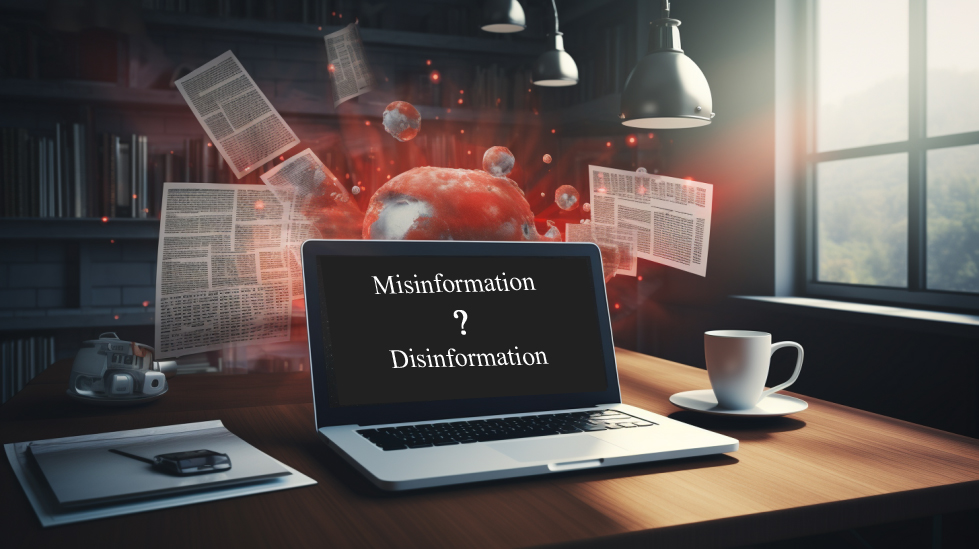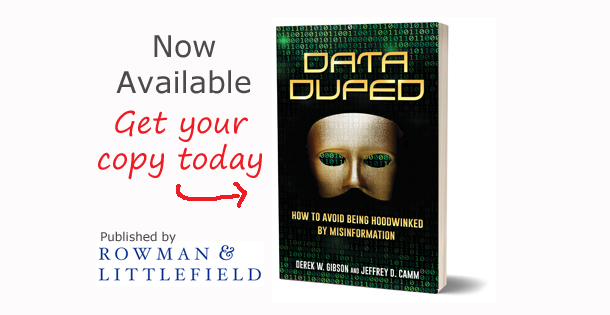
What is the difference between misinformation and disinformation and how do you know? This is the first part of building your data defense superpower and a pillar of our new book published by Rowman & Littlefield, Data Duped: How to Avoid Being Hoodwinked by Misinformation. Let’s start at the beginning.
There are many terms out there for deception. Fake news, hoaxes, falsehoods, trickery, and yes of course duping. These terms can all be grouped into two broad categories – disinformation and misinformation. And to know the difference between the two you need to know a little more about intent.
Disinformation
Depending on your personal level of data defense you probably find it easier to spot disinformation. Disinformation is when information is deliberately created to mislead someone. The purpose might be to sway someone’s beliefs or to nudge them toward a decision. Propaganda is the most common type of disinformation.
Great examples of disinformation are when foreign governments hoist false stories over the proverbial wall of truth into other nations. They are either trying to create political disruption or make whatever recent portrayal of themselves look better. A recent example is Russia’s claim that Ukraine was instead responsible for the destruction of the Kakhovka dam, which caused extensive damage within Ukraine. This is not new of course. Back in 1981 the Soviet government, fearful of the US gaining friends in Europe to stage defensive weapons, floated disinformation about President Carter’s involvement in the assignation attack on the Pope, which of course was completely untrue. The purpose was to disrupt the relationships between the US and Russia’s European neighbors.

Propaganda is not the only type of disinformation. We see it in other ways too such as claims that certain vitamins can “cure” your internal parasites and are the cause of (reversable?) autism. To make some of these claims more believable their ads and social media posts used ‘word trickery’. Instead of saying their claims are backed by clinical studies, they say the ingredients are backed by clinical studies. It sounds similar, believable, and is completely deceptive.
How do you build your data defense against disinformation? First, disinformation suffers from the most obvious missteps in data deception, which is the absence of data. Anytime you read some statement that could be supported by a number and it is not, you should be skeptical. Second, disinformation rarely has any supporting references. If it were true there should be a way to verify it from some other independent source.
When Data Deceives
Misinformation can be the result of poorly designed surveys, or lack of experience on how to properly analyze data (dealing with missing information and outliers for example). Bias can play a role too – we see what we want to see in the numbers spurred by our confirmation bias. What makes misinformation different from disinformation is the intent is not to deliberately to deceive someone. The data may just be bad data, or people have come to some false, unscientific conclusion about what it means.
Misinformation can be seen in social media news and readers should be cautious of claims from surveys with unexpected / attention grabbing headlines. Many surveys are well designed and analyzed but that is not always a guarantee they will not go astray. Surveys with few respondents (small samples), those that have vague conclusions such as “most agree” or “majority say” could be suspects of misinformation. They are in effect misinforming their readers (and maybe their writers too).
Topics that are controversial or are difficult to measure with numbers, like human emotions are ripe for misinformation. We wrote about the perils of measuring happiness in academic studies.
Faces of Data Duped
In our book, we write about the “faces of data dupers” as archetypes for disinformation and misinformation. The Devious Data Duper are the deliberate dupers. They are motivated by their ideas and they want to influence and manipulate others. They might be guilty of hand-picking data, filtering for what they need, and leaving out the rest.
Misinformation comes from the Unwitting Data Duper, an individual who may not be purposely deceiving their audience, and for either a lack of expertise, knowledge laziness, or haste they create data deception.
Building your data defense skills begins with being able to identify potential data deception. The nuances between misinformation and disinformation may seem subtle and it is important to consider the motivations of those providing the information. Is the intent to change your opinion or sell a product? Can the claims be supported with (real) data and can you fact check those claims from other sources? When you are doing this routinely you might find yourself further along your data journey than you think and less likely to be Data Duped.

[…] with Jeffrey Camm, called Data Duped. It’s a great book (trust me), on a great topic (Data, Misinformation, oh my!) and it could not come at a better time. AI is spinning like magic and the trust people […]
LikeLiked by 1 person